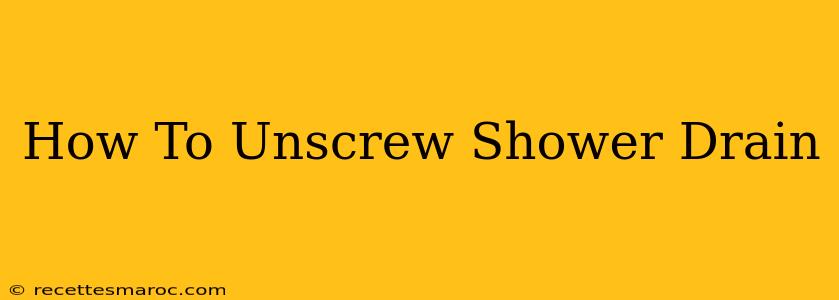Is your shower drain clogged, leaking, or just looking a little worse for wear? Replacing or repairing it might be the solution, but first, you'll need to know how to unscrew that shower drain. This process can seem daunting, but with the right tools and a little patience, you can tackle it yourself and save on costly plumber fees. This guide will walk you through the process, covering various drain types and offering helpful tips along the way.
Tools You'll Need
Before you begin, gather these essential tools:
- Screwdriver: You'll likely need both a flathead and a Phillips head screwdriver, depending on the type of screws securing your drain.
- Pliers (Channel-lock or slip-joint): These are helpful for gripping stubborn nuts or drain flanges.
- Basin wrench: This specialized tool is invaluable for reaching those hard-to-access nuts under the drain. If you anticipate needing this often, it's a worthwhile investment.
- Bucket: To catch any water that might spill during the process.
- Gloves: Protect your hands from grime and potential sharp edges.
- Optional: Penetrating oil (like WD-40): To loosen rusted or stuck screws and nuts.
Types of Shower Drains and How to Remove Them
Shower drains come in a variety of designs, but the basic removal process is similar. The biggest variations lie in the type of fasteners used:
1. Standard Shower Drain with Screws:
This is the most common type. Look for screws around the drain flange (the metal plate covering the drain opening).
- Remove the drain cover: Carefully pry up the drain cover if there is one. It might be secured by small clips or screws.
- Locate and remove screws: Use the appropriate screwdriver to remove the screws holding the drain flange in place. If they're rusty or stuck, apply penetrating oil and let it sit for a few minutes before attempting to unscrew them.
- Remove the drain flange: Once the screws are removed, carefully lift the drain flange. You might need to gently twist or wiggle it to break the seal.
- Unscrew the drain assembly: Underneath the flange, you'll find the main drain assembly. This often involves a large nut that needs to be unscrewed using pliers or a basin wrench. Turn counter-clockwise to loosen.
2. Shower Drain with a Slip Nut:
Some drains use a slip nut instead of screws. This is a nut that fits over the drain pipe and is tightened to secure the drain.
- Remove the drain cover (if applicable): As above, carefully remove any decorative cover.
- Loosen the slip nut: Use pliers or a basin wrench to loosen the slip nut. Turn counter-clockwise to loosen.
- Remove the drain assembly: Once the slip nut is loose, the drain assembly should be removable.
3. Pop-up Shower Drains:
These drains have a lever or knob to control water flow. The removal process is slightly different:
- Remove the drain cover: Take off the decorative cover.
- Access the linkage: You'll likely need to disconnect the linkage mechanism that controls the pop-up function. This may involve removing a few screws or clips. Consult your specific drain's instructions if needed.
- Loosen the nut: Use pliers or a basin wrench to loosen the nut securing the drain assembly.
Troubleshooting Tips:
- Stuck screws or nuts: Apply penetrating oil and let it sit for at least 15-20 minutes to help loosen the fasteners.
- Hard-to-reach nuts: A basin wrench is your best friend here.
- Broken drain parts: If any parts break during removal, take photos or make notes to ensure you can find replacement parts easily.
Important Note: If you're uncomfortable working with plumbing, it's always best to call a qualified plumber. Improper removal or installation could lead to leaks or further damage.
By following these steps, you'll be well on your way to successfully unscrewing your shower drain. Remember to be patient, take your time, and always prioritize safety. Good luck!

